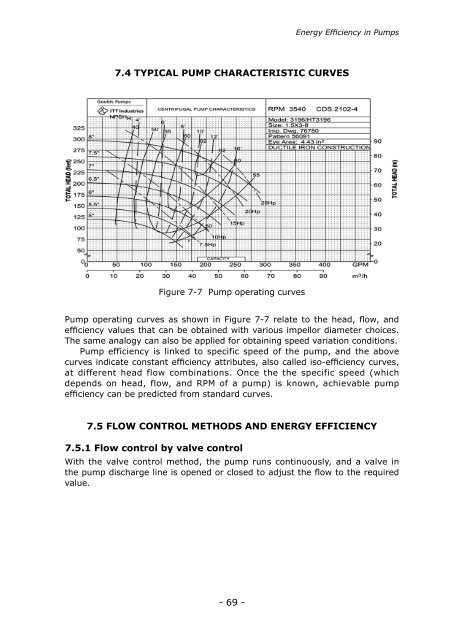Training Manual on Energy Efficiency - APO Asian Productivity ...
Training Manual on Energy Efficiency - APO Asian Productivity ...
Training Manual on Energy Efficiency - APO Asian Productivity ...
Create successful ePaper yourself
Turn your PDF publications into a flip-book with our unique Google optimized e-Paper software.
7.4 TYPICAL PUMP CHARACTERISTIC CURVES<br />
Figure 7-7 Pump operating curves<br />
Pump operating curves as shown in Figure 7-7 relate to the head, flow, and<br />
efficiency values that can be obtained with various impellor diameter choices.<br />
The same analogy can also be applied for obtaining speed variati<strong>on</strong> c<strong>on</strong>diti<strong>on</strong>s.<br />
Pump efficiency is linked to specific speed of the pump, and the above<br />
curves indicate c<strong>on</strong>stant efficiency attributes, also called iso-efficiency curves,<br />
at different head flow combinati<strong>on</strong>s. Once the the specific speed (which<br />
depends <strong>on</strong> head, flow, and RPM of a pump) is known, achievable pump<br />
efficiency can be predicted from standard curves.<br />
7.5 FLOW CONTROL METHODS AND ENERGY EFFICIENCY<br />
7.5.1 Flow c<strong>on</strong>trol by valve c<strong>on</strong>trol<br />
With the valve c<strong>on</strong>trol method, the pump runs c<strong>on</strong>tinuously, and a valve in<br />
the pump discharge line is opened or closed to adjust the flow to the required<br />
value.<br />
- 69 -<br />
<strong>Energy</strong> <strong>Efficiency</strong> in Pumps
















